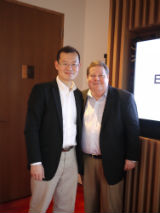Bridgelux's new generation of light-emitting diode (LED) array Vero will again challenge lower unit prices per lumen. In order to accelerate the realization of the sweet spot in the price of LED lamps, Bridgelux has actively adopted an improved chip-on-board (COB) packaging architecture to increase the density of LED arrays per lumen, thereby significantly reducing the unit price per LED.

Brian Fisher (right), Enterprise Marketing Director of Bridgelux Optoelectronics, said that the company's Vero will completely subvert the LED array products on the market and help customers develop more cost-effective LED lighting solutions. Left is Taiwan and Malaysia Sales Director Wang Weimin
Brian Fisher, Corporate Marketing Director of Bridgelux Optoelectronics, said that compared with the previous generation LED array, Bridgelux Vero series products use a redesigned COB packaging technology architecture to help increase the density of LED arrays per lumen and reduce the unit price of LED arrays per lumen; It can also improve the inconsistency of OpTIcal Fill and thermal inconsistency of each LED chip to simplify the complexity of selecting LED driver ICs; at the same time improve optical control and narrow beam (Narrow Beam) optics, which is conducive to designing a more compact And more precise light source.
Fisher pointed out that compared with LED array products on the market, Vero series products provide significantly higher lumens by several times under the same light source size, color temperature and color rendering, especially suitable for retail stores and street lamps For large-scale LED arrays, the difference in lumens can be as much as eight times. Vero series products have a luminous efficiency of 110 lumens per watt, a color temperature of 3,000K, a color rendering index (CRI) of up to 80 and a maximum lumens of 16,300 lumens.
On the other hand, Bridgelux also uses system-in-package (SiP) technology to integrate more optical components in the LED array to help LED lighting customers mass-produce more cost-effective solutions. Fisher emphasized that the price of LED lamps should be comparable to traditional light sources, and LED array packaging and lamp system design are two key factors. From the perspective of the cost of LED lamps, LED light sources currently only account for 25 to 30% of the total cost. It is obvious that the cost of LED light sources is no longer the biggest factor in determining the selling price of lamps. How to reduce the unit price of other components is also crucial.
Unlike previous-generation LED arrays and competitor products, Vero uses SiP technology to integrate two-dimensional (2D) barcodes, solder pads (Solder Pad), optical positioning (OpTIc LocaTIng) functions and other optical and functional components into the LED array. Significantly reduce the cost of customer development, manufacturing and assembly of other optical and functional components. Fisher said that in the future, the company also plans to integrate wireless technology, production history, sensors and other functions in the LED array to further realize smart light sources.
Fisher further revealed that the company's GaN-on-Si LED chips will be officially mass-produced in the first half of 2013. Once GaN-on-Si LEDs are used, LED arrays will be easier to integrate through SiP technology. Multi-function, can better meet the market trend of integrating more functions and components on a single LED array platform.
Semi-Round Sensor Automatic Dustbin
Stainless Trash Can,Semi-Round Sensor Automatic Dustbin,Semi-Round Series Sensor Dustbin,Semi-Round Sharp Sensor Dustbin
NINGBO ZIXING ELECTRONIC CO.,LTD. , https://www.zixingautobin.com